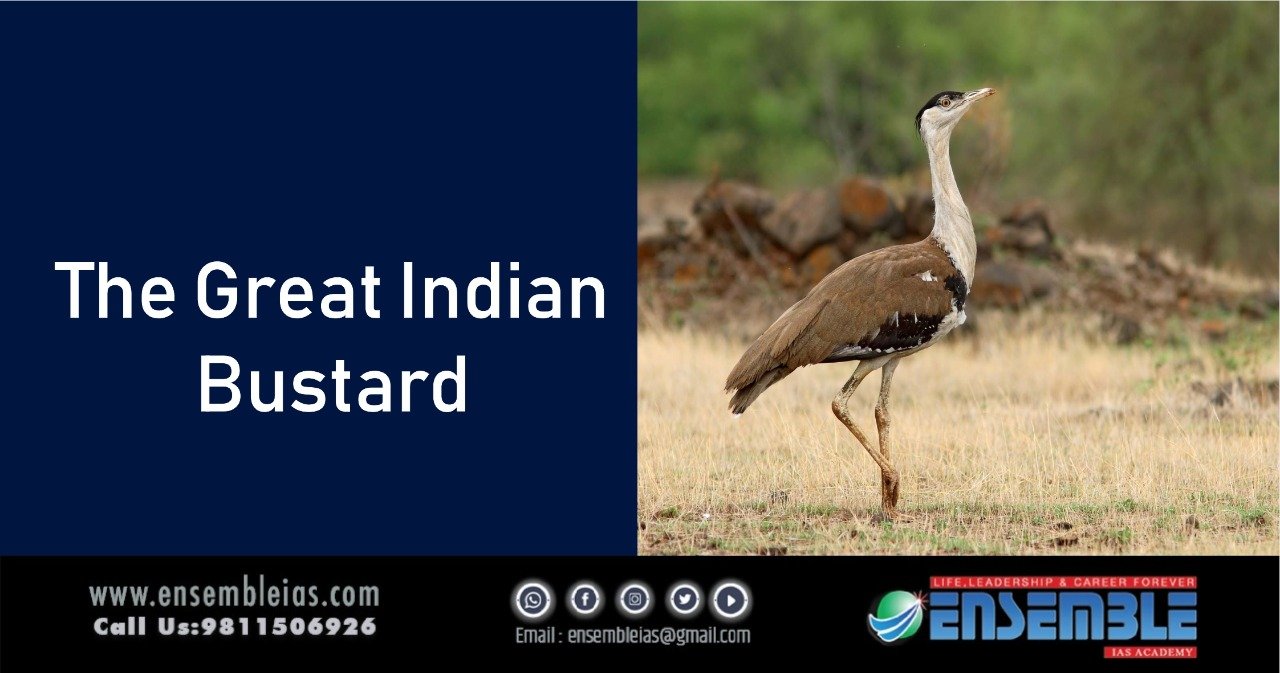The Great Indian Bustard: Why is it critically endangered and what is the government doing about it
Why in news:
Supreme Court had released the order to power companies to shift their overhead power lines underground in Great Indian Bustard (GIB) habitat in Rajasthan and Kutch to save the species from going extinct.
To buy our online courses: Click Here
Significance:
- GIBs are the largest among the four bustard species found in India, the other three being MacQueen’s bustard, lesser florican and the Bengal florican.
- GIBs’ historic range included much of the Indian sub-continent but it has now shrunken to just 10 percent of it.
- Among the heaviest birds with flight, GIBs prefer grasslands as their habitats.
- Being terrestrial birds, they spend most of their time on the ground with occasional flights to go from one part of their habitat to the other.
- They feed on insects, lizards, grass seeds etc.
- GIBs are considered the flagship bird species of grassland and hence barometers of the health of grassland ecosystems.
- Due to the species’ smaller population size, the International Union for Conservation of Nature (IUCN) has categorised GIBs as critically endangered, thus on the brink of extinction from the wild.
Fact:
The Central government had told the 13th Conference of Parties to the United Nations Convention on Migratory Species of Wild Animals (CMS) held in Gandhinagar, that the GIB population in India had fallen to just 150. Of them 128 birds were in Rajasthan, 10 in Kutch district of Gujarat and a few in Maharashtra, Karnataka and Andhra Pradesh
What is the issue with Power Transmission Lines:
- The research by Wildlife Institute of India (WII) has concluded that in Rajasthan that 18 GIBs die every year after colliding with overhead power lines as the birds, due to their poor frontal vision, can’t detect power lines in time and their weight makes in-flight quick manoeuvres difficult.
- Coincidentally, Kutch and Thar desert are the places which have witnessed creation of huge renewable energy infrastructure over the past two decades, leading to installation of windmills and construction of power lines even in core GIB habitat areas.
Another reason:
- Change in landscape by way of farmers cultivating their land, which otherwise used to remain fallow due to frequent droughts in Kutch, and cultivation of cotton and wheat instead of pulses and fodder are also cited as reasons for falling GIB numbers.
Absence in Kutch Bustard Sanctuary (KBS):
- KBS near Naliya in Kutch district’s Abdasa block is a tiny sanctuary notified in 1992 and spread over just two square kilometres (sqkm).
- Its eco-sensitive zone spread over 220 sqkm covers most of present-day core GIB habitat.
- The creation of safe-haven for the birds led to an increase in the GIB population in KBS—from 30 in 1999 to 45 in 2007.
- Windmills and powerlines started coming up right on the borders of the sanctuary from 2008 onward and GIB numbers started dwindling hence.
- The population fell to just 25 individuals by 2016 and field staff of KBS say, now there are only seven, all of them female.
- No male has been sighted for the past two years.
- Besides the KBS, Prajau, Bhanada and Kunathia-Bhachunda are important grasslands which have been declared unclassified forests recently.
- Due to the barrier created by the power infrastructure on all its sides, sightings of GIB inside the KBS’ notified two sqkm area is becoming increasingly rare.
GIB Species Recovery Program
- In 2015, the Central government launched the GIB species recovery programme.
- Under the programme, the WII and Rajasthan forest department have jointly set up conservation breeding centres where GIB eggs harvested from the wild are incubated artificially and hatchlings raised in controlled environment.
- Till 2020, nine eggs had hatched successfully and the plan is to create a population which can act as insurance against the threat of extinction and release the third generation of these captive-bred birds into the wild.





